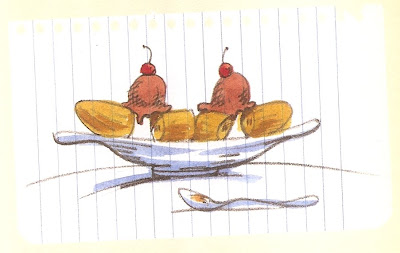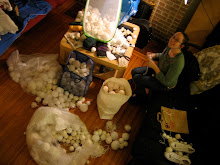And they're amazing! I guess it's unsurprising that he was so focused on food: so many of his sculptures ended up being edible objects. But what I loved about this book was that it not only gave me such clear insight into the sculptors' process but also into how he and Coosje sourced their inspiration.
At the end of the book there's this very sweet bit of writing by Claes: "Coosje and I have spent thirty years hardly ever apart, operating together as one imagination on whatever comes into view." He goes on to reveal that the reason they started sketching food was that Coosje developed food allergies: "What had been a pleasurable activity became a dangerous one." Unable or unwilling to give up the joys of food, however, Coosje suggested a "displacement of the senses- that which could not be eaten could be consumed by the eyes."
I, too, have been battling with my relationship to food. After years of constant stomach aches, my doctor suggested I stop eating gluten. I wept for the loss of bagels in my life... but I did it (mostly). A year and a half later, I returned to the doctor only to be told that- partially because I had stopped eating wheat- I had developed extreme iron-deficient anemia. So now my food choices are this crazy balancing act: how much gluten have I had today? Am I gonna feel like crap? Was it worth it? Will refusing to eat the bread/pasta/beer at this potluck make me feel too awkward and needy? What happens over time when you have to weigh every eating decision- run it through a rubric of qualifiers- is that eating stops being fun. It takes on this monumentality that is, ironically, all consuming.
I have no way of knowing if Coosje had a similar feelings about her diet... but the knowledge of our shared experiences helps me to see these sculptures in a new way. The scale of the object becomes a metaphor for it's relationship to the human body- a relationship that is especially poignant when you consider that the human body is supposed to consume the food object.
The sketches, as well as the sculptures, are without a doubt humorous and comical... but they are also a somewhat threatening: who exactly is in charge here? Is food's proper place in the world to be subjected by the human body? Or is the human body dependent upon food? The food becomes so large that it ends up taking on aspects of architecture.
From those sketches to the famous installations like this one:
 Spoonbridge and Cherry, 1988
Spoonbridge and Cherry, 1988Stainless steel and aluminum painted with polyurethane enamel
29 ft. 6 in. x 51 ft. 6 in. x 13 ft. 6 in. (9 x 15.7 x 4.1 m)
Minneapolis Sculpture Garden, Walker Art Center, Minneapolis, Minnesota
As I am spending increasing amounts of time in my studio it becomes more and more important for me to gain insight into the inspirational processes of artists I like. Without the structure of academic education, it's becoming harder for me to find my path... to know what to make next and why. I find that my brain is swirling with ideas but none of them seem important enough to be worth following through on. I think it's good for me to see how other aspects of my life- like my relationship to food- are viable sources of artistic inspiration. Thanks, Claes and Coosje!
But most importantly- where's the giant sculpture of this guy??
Bibliography:
Images a la Carte, by Claes Oldenburg and Coosje Van Bruggen. Paula Cooper Gallery, New York, 2004.
http://oldenburgvanbruggen.com/
http://en.wikipedia.org/wiki/Claes_Oldenburg
http://en.wikipedia.org/wiki/Coosje_van_bruggen










.JPG)

2 comments:
I believe he became the muppet known as Pepe the Prawn.
YES! I thought he looked familiar...
Post a Comment